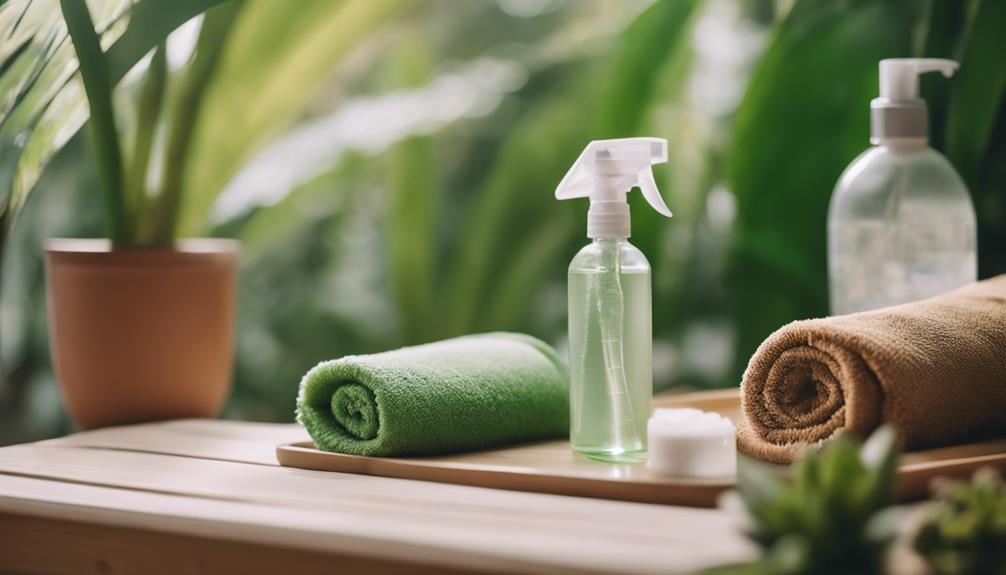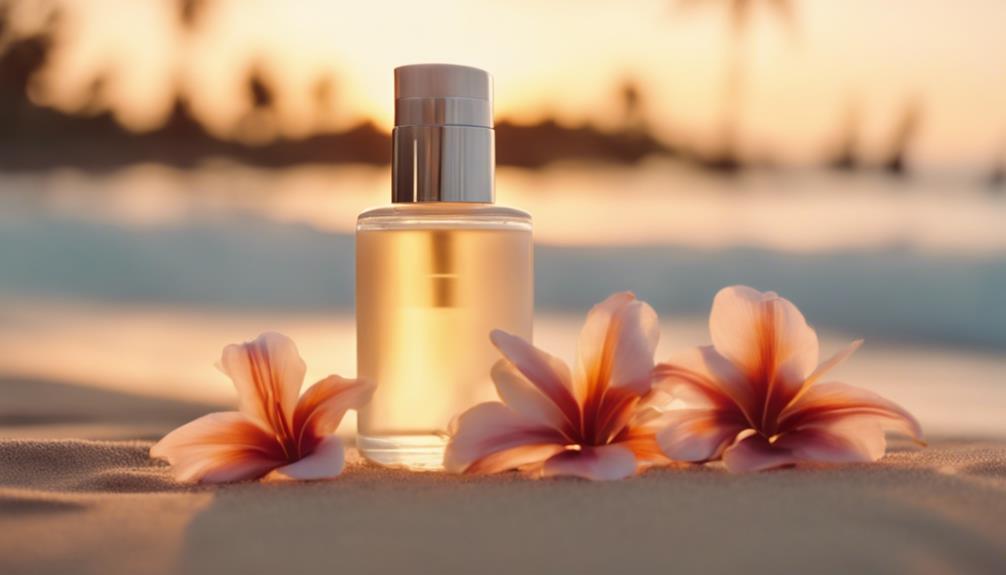To keep tanning beds clean and eco-friendly, try using natural solutions like a vinegar and water mix or hydrogen peroxide in a spray bottle. These options effectively sanitize without harmful chemicals. For tougher grime, a baking soda paste works wonders. Additionally, look for eco-friendly commercial cleaners with recyclable packaging and natural ingredients. Regularly wipe down surfaces with a microfiber cloth, and don't forget to sanitize the bulbs. A consistent cleaning routine promotes a safe and pleasant tanning environment. Stay tuned to discover more sustainable methods that enhance your tanning experience!
Key Takeaways
- Use a vinegar and water solution for a natural disinfectant that effectively sanitizes tanning beds without harmful chemicals.
- Spray hydrogen peroxide on surfaces to eliminate germs while being eco-friendly and safe for users.
- Regularly clean filters to enhance air quality and maintain a hygienic tanning environment.
- Schedule monthly deep cleaning sessions using eco-friendly products like baking soda and lemon juice for effective scrubbing and disinfection.
Natural Cleaning Solutions
When it comes to sanitizing tanning beds, natural cleaning solutions like vinegar and hydrogen peroxide not only keep the environment safe but also guarantee a thorough clean.
You can create a vinegar-based solution by mixing equal parts white vinegar and water. This mixture disinfects while leaving a fresh scent, especially if you add a few drops of tea tree or lemon essential oils.
Hydrogen peroxide is another great option; just fill a spray bottle for easy application.
For a more robust scrub, mix baking soda with warm water into a paste to tackle grime.
Additionally, lemon juice diluted with water offers a pleasant citrus scent while disinfecting.
These solutions assure a clean and safe tanning environment without harsh chemicals.
Eco-Friendly Commercial Options

Eco-friendly commercial cleaners offer a reliable way to sanitize tanning beds while protecting both your health and the environment.
These products eliminate harmful chemicals, guaranteeing a safe experience for you and your clients.
Look for cleaners that come in recyclable packaging and are gentle on the skin, helping to minimize irritation.
Many eco-friendly options contain natural ingredients like tea tree oil and lemon, which provide effective sanitation without compromising sustainability.
By incorporating these cleaners into your routine, you not only maintain hygiene but also support eco-conscious practices.
Regular use of these products guarantees a clean and inviting tanning environment, allowing you to enjoy your tanning sessions while being mindful of the planet's well-being.
Effective Cleaning Techniques

Utilizing effective cleaning techniques guarantees your tanning beds remain sanitary and safe for clients.
Start by mixing equal parts of white vinegar and water for a natural disinfectant. Spray the solution on surfaces and wipe them down with a microfiber cloth. For a fresh scent, consider adding essential oils like tea tree or lemon.
Alternatively, use hydrogen peroxide in a spray bottle for easy application. It's a powerful germ eliminator without harsh chemicals.
You can also create a paste with baking soda and warm water to scrub away grime and dead skin.
Regularly clean and replace filters to maintain air quality, ensuring a hygienic tanning environment for everyone.
A consistent routine will keep your beds in top condition!
Deep Cleaning Procedures

To guarantee a thorough and effective deep cleaning of tanning beds, start by unplugging the unit to prioritize safety.
Next, gather eco-friendly cleaning solutions like vinegar and baking soda. Use a soft brush with your cleaner to scrub nooks and crannies, making sure you reach all surfaces.
Remove and sanitize the bulbs, as they can harbor germs. After scrubbing, wipe down all surfaces with a microfiber cloth to remove any residue.
Schedule these deep cleaning sessions monthly to maintain hygiene and extend the life of your tanning beds.
Finally, make certain of proper ventilation by regularly cleaning and replacing filters to keep the air quality fresh.
Safety Measures for Tanning
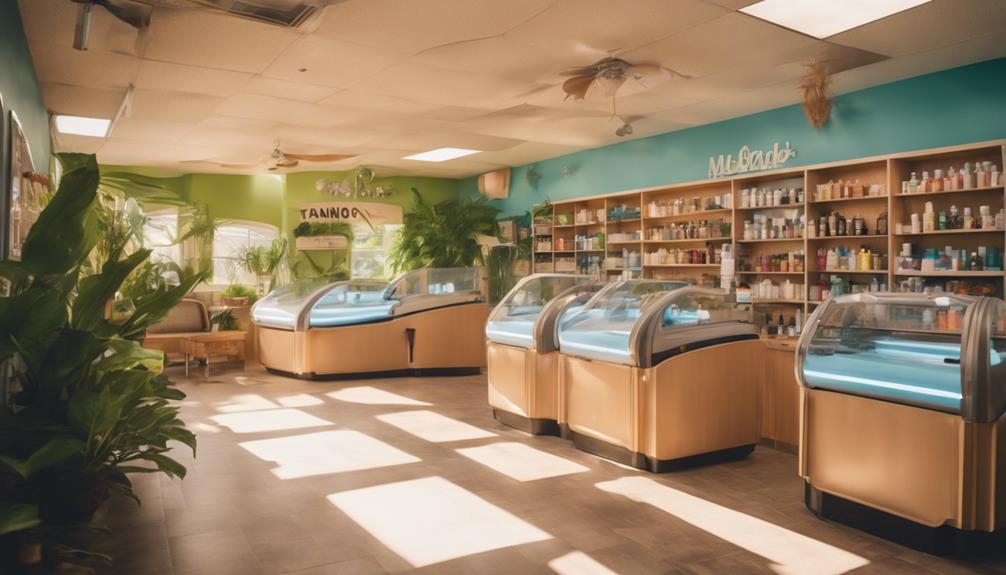
After guaranteeing your tanning bed is thoroughly cleaned, it's important to prioritize safety measures to protect your skin and eyes during tanning sessions.
Always wear goggles with 100% UV protection to shield your eyes from harmful rays. Look for wraparound styles to minimize side exposure and guarantee a secure fit.
You should also apply a broad-spectrum sunscreen to any exposed skin, even if you're using a tanning bed. Avoid tanning if you have any skin irritations or conditions, as this can lead to further complications.
Finally, limit your tanning duration to avoid overexposure, and take breaks between sessions to allow your skin to recover.
Following these safety measures will enhance your tanning experience while protecting your health.
Skin Preparation Guidelines
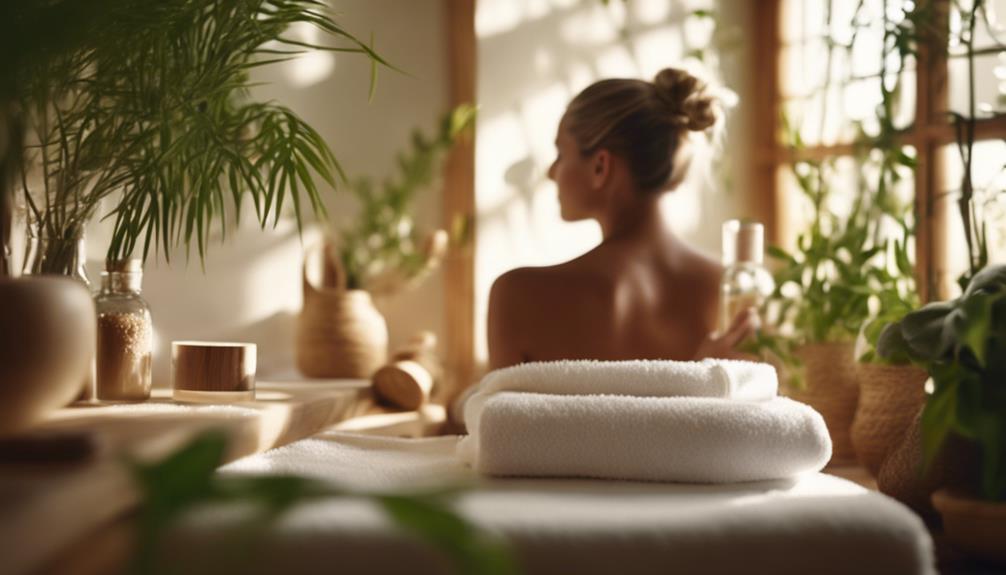
Preparing your skin properly before tanning is essential for achieving a beautiful, even tan and protecting your skin's health. Follow these guidelines for ideal results:
Exfoliate your skin 24 hours prior to remove dead skin cells.
Moisturize daily to enhance hydration and prevent dryness.
Avoid lotions with oils or fragrances before tanning to prevent uneven application.
Perform patch tests to check for any sensitivities to tanning products.
Stay hydrated by drinking plenty of water to maintain skin elasticity.
Sustainable Sanitization Practices
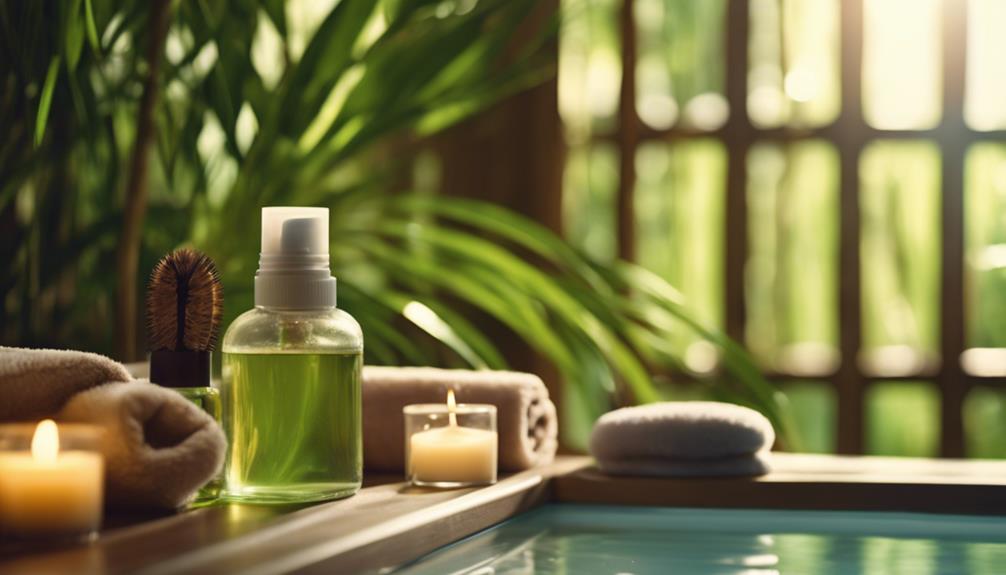
Sustainable sanitization practices for tanning beds focus on using eco-friendly cleaning agents and methods that protect both your skin and the environment.
You can start by using vinegar-based solutions or hydrogen peroxide, which effectively disinfect without harsh chemicals. Mixing lemon juice with water also provides a natural alternative with a fresh scent. Incorporate baking soda for scrubbing away grime while deodorizing the bed.
For deeper cleaning, consider using UV-C light technology to eliminate germs sustainably. Always opt for plant-based disinfectants and washable, reusable cleaning supplies to minimize waste.
Regular training for staff on these green practices guarantees everyone contributes to a healthier tanning environment, keeping both your clients and the planet in mind.
Frequently Asked Questions
How Often Should Tanning Beds Be Cleaned for Optimal Hygiene?
You should clean tanning beds after every use to guarantee ideal hygiene. Regular maintenance prevents bacteria buildup, enhances user experience, and promotes a healthy environment. Don't forget to schedule deeper cleanings monthly for thorough sanitation.
Can I Use Regular Household Cleaners on Tanning Beds?
Did you know that nearly 80% of household cleaners contain harmful chemicals? You shouldn't use regular household cleaners on tanning beds; they can damage the surface and compromise your skin's health. Stick to eco-friendly options instead.
Are There Specific Products to Avoid for Tanning Bed Cleaning?
You should avoid harsh chemicals, bleach, and ammonia-based products when cleaning tanning beds. These can damage surfaces and affect your skin. Stick to gentle, natural cleaners to guarantee a safe and effective sanitizing routine.
How Can I Tell if My Tanning Bed Is Clean Enough?
When your tanning bed sparkles like a fresh morning dew, it's clean enough. Look for no visible dirt, a pleasant scent, and feel confident that you've wiped down all surfaces thoroughly to guarantee a safe experience.
What Are the Benefits of Using Eco-Friendly Cleaners for Tanning Beds?
Using eco-friendly cleaners for tanning beds guarantees a safer environment for you and your clients. They reduce chemical exposure, promote healthier skin, and support sustainability, all while providing effective sanitation and maintaining a fresh, pleasant atmosphere.
Conclusion
By embracing eco-friendly tactics for tanning bed sanitation, you're not just protecting your skin; you're nurturing the planet too.
Think of it as planting seeds of sustainability while basking in your glow.
With natural cleaners and mindful practices, you create a sanctuary that's safe and inviting.
So, as you step into that tanning bed, know you're not just catching rays—you're catching a wave of positive change for yourself and the Earth.
Shine bright, responsibly!

